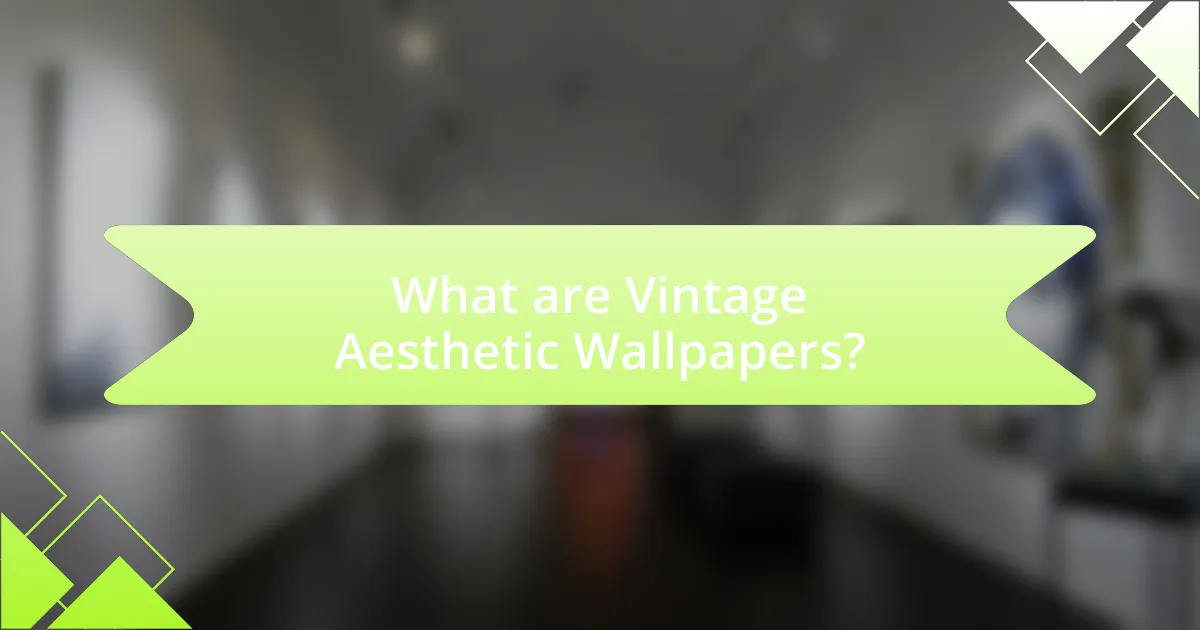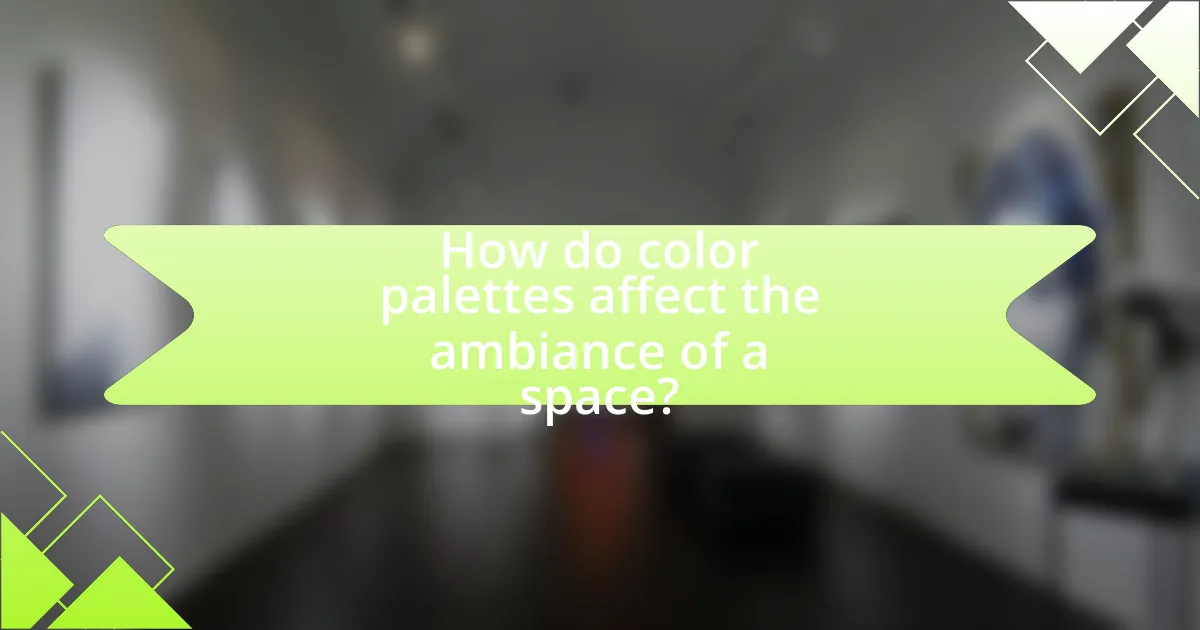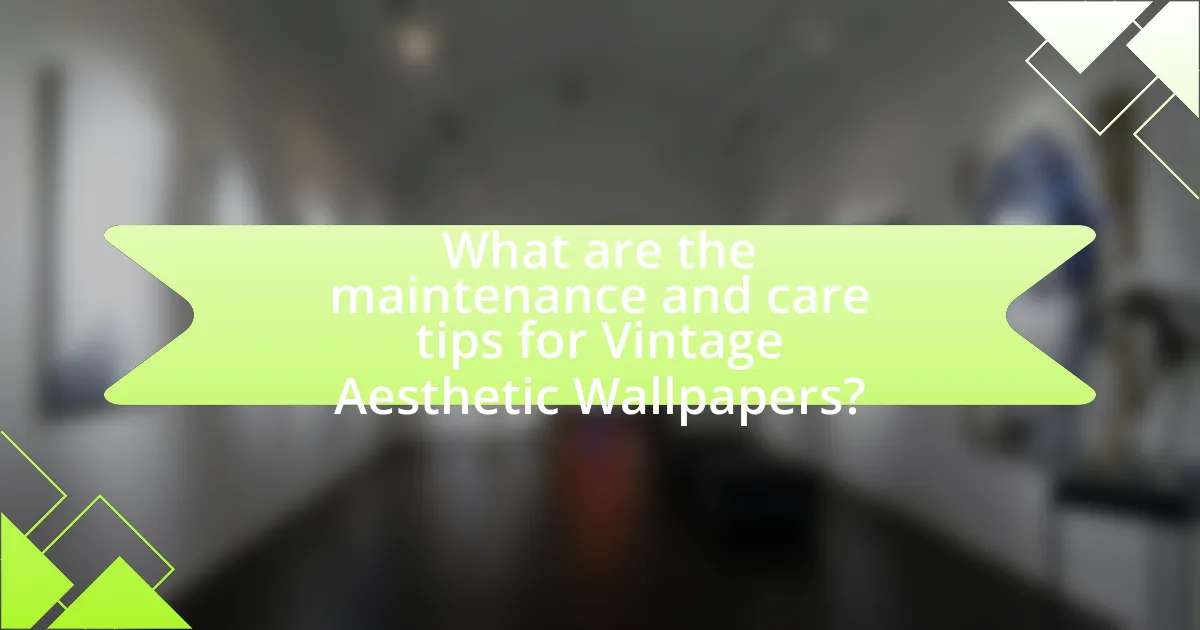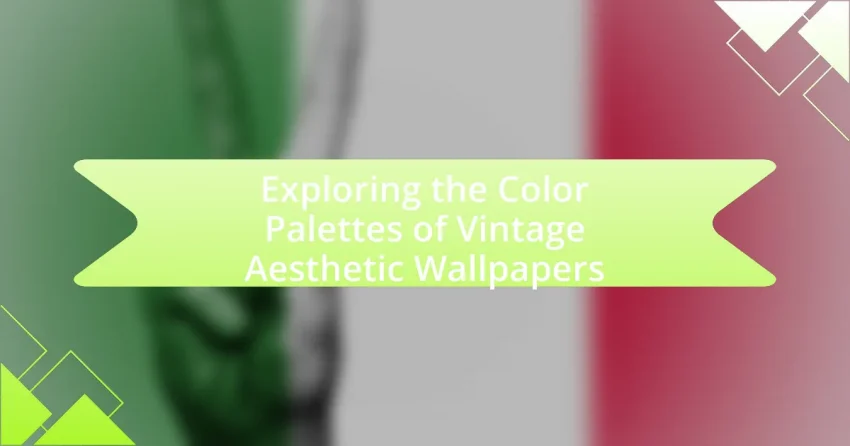Vintage aesthetic wallpapers are decorative wall coverings that evoke nostalgia through their designs, color palettes, and patterns, primarily from the late 19th to mid-20th century. This article explores the characteristics of these wallpapers, including their historical influences, common motifs, and the significance of color palettes in creating ambiance. It also discusses how to integrate vintage wallpapers into modern spaces, the importance of maintaining their integrity, and practical tips for enhancing their use. Key themes include the psychological effects of color, the impact of cultural trends on design, and best practices for achieving a cohesive look in interior design.

What are Vintage Aesthetic Wallpapers?
Vintage aesthetic wallpapers are decorative wall coverings that evoke a sense of nostalgia through their design, color palettes, and patterns reminiscent of past eras, particularly from the late 19th to mid-20th century. These wallpapers often feature floral motifs, geometric shapes, and muted or pastel colors, which reflect the artistic styles and cultural influences of their time. The appeal of vintage aesthetic wallpapers lies in their ability to create a warm, inviting atmosphere, often associated with retro or antique decor. Their popularity has surged in contemporary interior design, as they provide a unique way to incorporate historical charm into modern spaces.
How do Vintage Aesthetic Wallpapers differ from modern designs?
Vintage aesthetic wallpapers differ from modern designs primarily in their color palettes and patterns. Vintage wallpapers often feature muted, earthy tones and intricate, ornate patterns that evoke nostalgia, reflecting styles from the late 19th to mid-20th centuries. In contrast, modern designs typically utilize bold, vibrant colors and minimalistic patterns, focusing on simplicity and functionality. Historical context supports this distinction, as vintage wallpapers were influenced by art movements like Art Nouveau and Arts and Crafts, which emphasized craftsmanship and detail, while modern designs are often influenced by contemporary trends that prioritize clean lines and open spaces.
What historical influences shape Vintage Aesthetic Wallpapers?
Vintage aesthetic wallpapers are shaped by historical influences such as the Arts and Crafts Movement, Art Nouveau, and mid-20th century design trends. The Arts and Crafts Movement, which emerged in the late 19th century, emphasized handcrafted quality and natural motifs, leading to wallpapers featuring floral patterns and earthy color palettes. Art Nouveau, popular from the 1890s to the early 1900s, introduced organic forms and flowing lines, influencing wallpaper designs with intricate, nature-inspired graphics. Additionally, mid-20th century design trends, particularly the retro styles of the 1950s and 1960s, brought bold colors and geometric patterns, further diversifying the vintage aesthetic. These movements collectively contribute to the rich visual language found in vintage wallpapers, reflecting cultural values and artistic innovations of their respective eras.
How do cultural trends impact the design of Vintage Aesthetic Wallpapers?
Cultural trends significantly influence the design of Vintage Aesthetic Wallpapers by dictating color palettes, patterns, and motifs that resonate with contemporary tastes. For instance, the resurgence of interest in mid-century modern design has led to the incorporation of bold colors and geometric patterns reminiscent of that era, reflecting a collective nostalgia. Additionally, the rise of eco-consciousness has prompted designers to use sustainable materials and earthy tones, aligning with current values around environmental responsibility. Historical context also plays a role; for example, the popularity of Art Deco in the 1920s is echoed in modern designs that feature luxurious textures and metallic finishes, showcasing how past aesthetics are reinterpreted to fit modern sensibilities.
What are the key characteristics of Vintage Aesthetic Wallpapers?
Vintage aesthetic wallpapers are characterized by their nostalgic designs, muted color palettes, and intricate patterns. These wallpapers often feature floral motifs, damask patterns, and geometric shapes that evoke a sense of history and charm. The color schemes typically include soft pastels, earthy tones, and faded hues, which contribute to their vintage appeal. Historical context shows that these designs were popular in the late 19th and early 20th centuries, reflecting the artistic movements of those times, such as Art Nouveau and Arts and Crafts. The combination of these elements creates a warm, inviting atmosphere that is sought after in interior design today.
What patterns and motifs are commonly found in these wallpapers?
Common patterns and motifs found in vintage aesthetic wallpapers include floral designs, geometric shapes, damask patterns, and stripes. Floral designs often feature intricate, repeating arrangements of flowers and leaves, reflecting the natural beauty of the era. Geometric shapes provide a modern contrast, with bold lines and symmetrical forms that create visual interest. Damask patterns, characterized by their ornate and textured appearance, add a touch of elegance and sophistication. Stripes, whether vertical or horizontal, are frequently used to create a sense of height or width in a space. These motifs are rooted in historical design trends, with floral and damask patterns prevalent in the Victorian era, while geometric shapes gained popularity in the mid-20th century.
How do textures and materials contribute to the vintage aesthetic?
Textures and materials significantly enhance the vintage aesthetic by evoking a sense of nostalgia and authenticity. Natural materials such as wood, linen, and aged leather create a tactile experience that reflects historical craftsmanship, while textures like distressed finishes and patinas add depth and character. For instance, wallpapers featuring intricate patterns and textured surfaces often mimic designs from past eras, reinforcing the vintage feel. The use of muted color palettes, often found in vintage wallpapers, complements these textures, creating a cohesive look that transports viewers to earlier times.
Why are color palettes important in Vintage Aesthetic Wallpapers?
Color palettes are important in Vintage Aesthetic Wallpapers because they evoke nostalgia and create a specific emotional atmosphere. The selection of colors in these wallpapers often reflects historical trends and cultural influences from the past, enhancing the vintage appeal. For example, muted tones and pastel shades commonly found in vintage designs are associated with the aesthetics of the early to mid-20th century, which can transport viewers to that era. This connection to history is reinforced by the fact that color choices can influence mood and perception, making the right palette essential for achieving the desired vintage aesthetic.
What role do colors play in evoking nostalgia and emotion?
Colors play a significant role in evoking nostalgia and emotion by triggering memories and associations linked to past experiences. Research indicates that specific colors can elicit particular feelings; for instance, warm colors like red and orange often evoke warmth and comfort, while cooler colors like blue can induce calmness and reflection. A study published in the journal “Color Research and Application” by researchers from the University of California found that colors can influence emotional responses and memory recall, demonstrating that individuals often associate certain colors with specific time periods or personal experiences. This connection between colors and emotions is particularly evident in vintage aesthetic wallpapers, where muted tones and pastel shades can transport individuals back to earlier eras, enhancing feelings of nostalgia.
How do color combinations enhance the overall design?
Color combinations enhance overall design by creating visual harmony and emotional impact. Effective color palettes can evoke specific feelings, guide viewer attention, and establish brand identity. For instance, complementary colors, which are opposite each other on the color wheel, can create vibrant contrasts that draw the eye, while analogous colors, which are next to each other, promote a sense of tranquility and cohesion. Research indicates that color influences perception; a study by the Institute for Color Research found that people make a subconscious judgment about a person, environment, or product within 90 seconds, and between 62% to 90% of that assessment is based on color alone. Thus, strategic use of color combinations is essential in design to enhance aesthetic appeal and functionality.
How can one choose the right color palette for Vintage Aesthetic Wallpapers?
To choose the right color palette for Vintage Aesthetic Wallpapers, one should focus on muted tones, pastel shades, and earthy colors that evoke nostalgia. These colors often include soft pinks, faded blues, and warm browns, which are characteristic of vintage design trends from the 1920s to the 1970s. Historical context shows that these palettes were popularized during periods when natural dyes were used, resulting in softer, less saturated colors. Additionally, examining vintage photographs and design magazines can provide insight into effective combinations that resonate with the vintage aesthetic.
What are the most popular color palettes in Vintage Aesthetic Wallpapers?
The most popular color palettes in Vintage Aesthetic Wallpapers include muted pastels, earthy tones, and rich jewel colors. Muted pastels, such as soft pinks, light blues, and pale yellows, evoke a nostalgic feel reminiscent of the 1950s and 1960s. Earthy tones, including olive greens, terracotta, and warm browns, reflect a connection to nature and vintage design trends from the mid-20th century. Rich jewel colors like deep emerald, sapphire, and ruby add a luxurious touch, often seen in wallpapers inspired by Victorian and Art Deco styles. These palettes are favored for their ability to create a warm, inviting atmosphere while maintaining a classic aesthetic.
What colors are typically associated with specific vintage styles?
Colors typically associated with specific vintage styles include muted tones, pastels, and earth tones. For example, the Victorian style often features rich jewel tones like deep reds and greens, while the Art Deco style is characterized by bold colors such as gold, black, and vibrant blues. Mid-century modern design typically incorporates softer hues like mustard yellow, avocado green, and light blue. These color associations are rooted in the historical context of each style, reflecting the materials and aesthetics popular during their respective eras.
How do seasonal trends influence color choices in vintage designs?
Seasonal trends significantly influence color choices in vintage designs by dictating the palette that resonates with the mood and aesthetics of each season. For instance, spring often features pastel colors like soft pinks and light greens, reflecting the renewal of nature, while autumn tends to embrace warm hues such as burnt orange and deep reds, evoking the changing leaves. Historical data shows that during the 1970s, designers frequently utilized earthy tones in fall collections, aligning with the cultural shift towards naturalism and sustainability. This cyclical relationship between seasons and color choices in vintage designs highlights how societal influences and environmental changes shape aesthetic preferences over time.

How do color palettes affect the ambiance of a space?
Color palettes significantly influence the ambiance of a space by evoking specific emotions and setting the overall mood. For instance, warm colors like reds and oranges can create a cozy and inviting atmosphere, while cool colors such as blues and greens tend to promote calmness and relaxation. Research indicates that color can affect psychological responses; for example, a study published in the journal “Color Research and Application” found that colors can alter perceptions of temperature and space, impacting how individuals feel within an environment. Thus, the choice of color palette directly shapes the experience and emotional response of those inhabiting the space.
What psychological effects do colors have in interior design?
Colors in interior design significantly influence psychological responses, affecting mood, behavior, and perception of space. For instance, warm colors like red and orange can evoke feelings of warmth and energy, while cool colors such as blue and green promote calmness and relaxation. Research indicates that color can impact cognitive performance; a study published in the journal “Color Research and Application” found that blue environments enhance creativity, while red environments improve attention to detail. Thus, the choice of color in interior design is crucial for creating desired emotional atmospheres and functional spaces.
How can warm and cool colors change the perception of a room?
Warm colors, such as reds, oranges, and yellows, can make a room feel more inviting and cozy, while cool colors, including blues, greens, and purples, tend to create a calming and spacious atmosphere. The psychological effects of these colors influence how individuals perceive the size and mood of a room; for instance, warm colors can make a space feel smaller and more intimate, whereas cool colors can give the impression of a larger, more open area. Research indicates that color temperature affects emotional responses, with warm colors often associated with energy and excitement, while cool colors are linked to tranquility and relaxation. This understanding of color perception is crucial in interior design, as it allows for the intentional manipulation of space and ambiance through color choices.
What are the best practices for using color to create a cohesive look?
The best practices for using color to create a cohesive look include selecting a limited color palette, ensuring color harmony through complementary and analogous colors, and maintaining consistent color usage across elements. A limited color palette, typically consisting of three to five colors, helps to unify the design and prevent visual clutter. Complementary colors, which are opposite each other on the color wheel, create contrast and vibrancy, while analogous colors, which are next to each other, provide a more subtle and harmonious effect. Consistent application of these colors across various elements, such as backgrounds, text, and decorative features, reinforces the overall aesthetic. Research indicates that cohesive color schemes enhance visual appeal and user experience, making designs more engaging and effective.
How can Vintage Aesthetic Wallpapers be integrated into modern spaces?
Vintage aesthetic wallpapers can be integrated into modern spaces by using them as accent walls or focal points, which creates a striking contrast with contemporary decor. This approach allows the rich textures and patterns of vintage designs to enhance the overall aesthetic without overwhelming the space. For instance, pairing a floral vintage wallpaper with minimalist furniture can create a balanced look that highlights both styles. Additionally, incorporating vintage wallpapers in smaller areas, such as powder rooms or hallways, can add character and charm while maintaining a modern feel. The successful integration of these wallpapers is supported by design principles that emphasize contrast and harmony, making them a versatile choice in modern interior design.
What are effective ways to mix vintage wallpapers with contemporary decor?
Effective ways to mix vintage wallpapers with contemporary decor include selecting a cohesive color palette, using vintage wallpaper as an accent wall, and balancing patterns. A cohesive color palette ensures that the colors in the vintage wallpaper complement the contemporary furnishings, creating a harmonious look. Utilizing vintage wallpaper on an accent wall draws attention without overwhelming the space, allowing contemporary elements to shine. Balancing patterns involves pairing bold vintage designs with simpler contemporary pieces to maintain visual interest while preventing clashing. These strategies are supported by interior design principles that emphasize harmony and balance in decor.
How can one maintain balance between vintage and modern elements?
To maintain balance between vintage and modern elements, one should strategically combine contemporary designs with classic features. For instance, using modern furniture alongside vintage wallpaper can create a harmonious aesthetic. This approach allows the timeless appeal of vintage elements to complement the sleekness of modern styles, ensuring that neither overshadows the other. Historical design principles, such as the use of color theory, support this balance; for example, pairing muted vintage colors with bold modern accents can enhance visual interest while maintaining cohesion.

What are the maintenance and care tips for Vintage Aesthetic Wallpapers?
To maintain and care for vintage aesthetic wallpapers, it is essential to keep them clean and protected from moisture. Regularly dusting the wallpaper with a soft, dry cloth prevents dirt buildup and preserves its appearance. Additionally, using a gentle, damp sponge for spot cleaning can help remove stains without damaging the wallpaper. It is crucial to avoid harsh chemicals or abrasive materials, as these can lead to fading or tearing. Furthermore, maintaining a stable indoor humidity level, ideally between 30% and 50%, helps prevent mold growth and deterioration. These practices ensure the longevity and aesthetic appeal of vintage wallpapers, which are often made from delicate materials that require careful handling.
How can one preserve the integrity of vintage wallpapers?
To preserve the integrity of vintage wallpapers, one should maintain a stable environment with controlled temperature and humidity levels. Fluctuations in these conditions can lead to deterioration, such as peeling or fading. Additionally, using UV-filtering window treatments can protect the wallpaper from sunlight, which can cause colors to fade over time. Regular dusting with a soft brush or cloth helps prevent dirt accumulation that can damage the surface. Furthermore, avoiding the use of harsh chemicals or abrasive cleaning methods is crucial, as these can strip the wallpaper of its original finish and integrity. Historical preservation guidelines recommend these practices to ensure the longevity of vintage materials.
What cleaning methods are safe for delicate vintage materials?
Safe cleaning methods for delicate vintage materials include using a soft, dry microfiber cloth for dusting, gentle vacuuming with a low-suction attachment, and spot cleaning with a mixture of mild soap and water applied with a soft cloth. These methods minimize the risk of damage to fragile fabrics and surfaces. For instance, using a microfiber cloth reduces the likelihood of scratching, while a gentle vacuum can remove debris without pulling on the material. Additionally, the use of mild soap ensures that no harsh chemicals compromise the integrity of the vintage items.
How can one protect vintage wallpapers from fading and damage?
To protect vintage wallpapers from fading and damage, one should apply UV-filtering window films or use curtains to block direct sunlight. This method significantly reduces the exposure to harmful UV rays, which are known to cause fading over time. Additionally, maintaining a stable indoor climate with controlled humidity levels prevents deterioration caused by moisture and temperature fluctuations. Regular cleaning with a soft, dry cloth helps remove dust without damaging the wallpaper. These practices are supported by conservation guidelines from institutions like the National Park Service, which emphasize the importance of light control and environmental stability in preserving historical materials.
What are some common mistakes to avoid when using Vintage Aesthetic Wallpapers?
Common mistakes to avoid when using Vintage Aesthetic Wallpapers include selecting colors that clash with existing decor, failing to consider the scale of patterns, and neglecting the lighting in the room. Choosing wallpapers with colors that do not harmonize with furniture or accessories can create a disjointed look. Additionally, using large patterns in small spaces can overwhelm the area, while small patterns in large rooms may get lost. Proper lighting is crucial, as it can alter the appearance of colors; inadequate lighting may make vibrant colors appear dull.
How can poor color choices detract from the vintage aesthetic?
Poor color choices can significantly detract from the vintage aesthetic by disrupting the harmonious and nostalgic feel that defines this style. Vintage aesthetics often rely on muted, earthy tones or pastel shades that evoke a sense of history and warmth; when bright or overly saturated colors are used, they can create a jarring contrast that feels modern and out of place. For instance, a study on color theory indicates that colors like faded greens, soft pinks, and warm browns are commonly associated with vintage designs, while neon or overly vibrant colors can clash with the intended retro vibe. This mismatch can lead to a loss of authenticity and emotional resonance, making the overall design feel less cohesive and appealing.
What are the pitfalls of overusing vintage patterns in a space?
Overusing vintage patterns in a space can lead to visual chaos and a lack of cohesion. When multiple vintage patterns are combined without careful consideration, they can compete for attention, making the space feel cluttered and overwhelming. This can detract from the intended aesthetic and create a disjointed atmosphere. Additionally, excessive use of vintage patterns may date the space, as trends in design evolve, leading to a less timeless appeal. Research indicates that balanced design, which incorporates a mix of patterns and solid colors, enhances visual harmony and overall comfort in interior spaces.
What practical tips can enhance the use of Vintage Aesthetic Wallpapers?
To enhance the use of Vintage Aesthetic Wallpapers, consider selecting complementary color palettes that reflect the era of the wallpaper, such as muted pastels or rich jewel tones. These colors can create a cohesive look that resonates with the vintage theme. Additionally, layering wallpapers with different patterns can add depth and interest to a space, while ensuring that the patterns share a common color scheme to maintain harmony. Using vintage-inspired decor items, such as antique furniture or retro accessories, can further accentuate the wallpaper’s aesthetic. Finally, proper lighting is crucial; soft, warm lighting can enhance the vintage feel and highlight the wallpaper’s textures and colors effectively.
